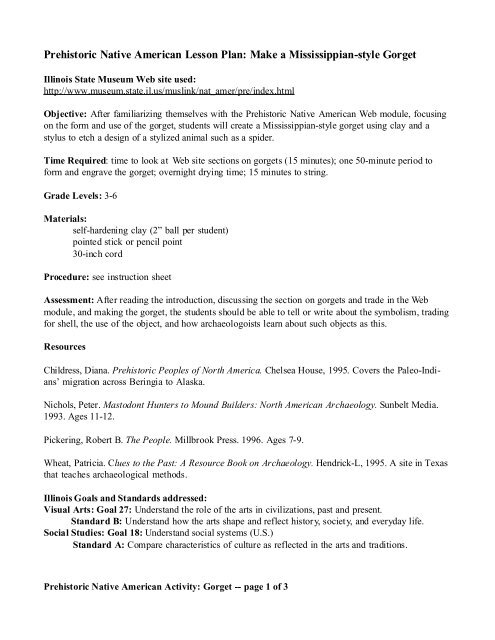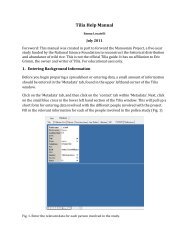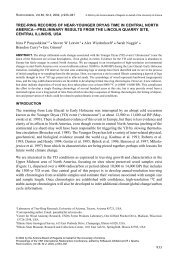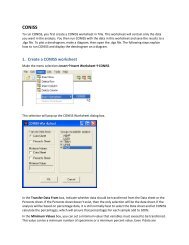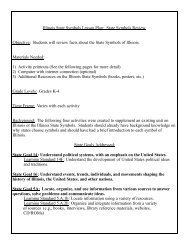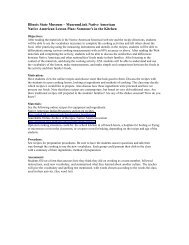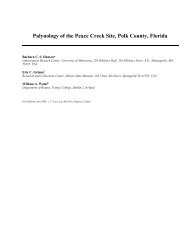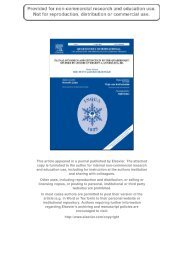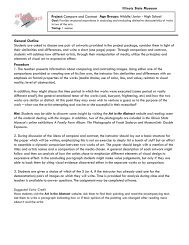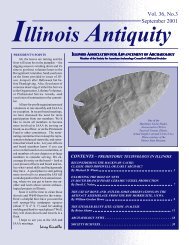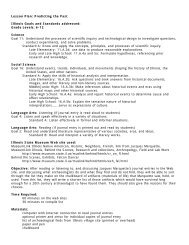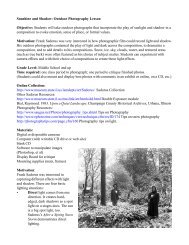Make a Mississippian-style Gorget - Illinois State Museum
Make a Mississippian-style Gorget - Illinois State Museum
Make a Mississippian-style Gorget - Illinois State Museum
You also want an ePaper? Increase the reach of your titles
YUMPU automatically turns print PDFs into web optimized ePapers that Google loves.
Prehistoric Native American Lesson Plan: <strong>Make</strong> a <strong>Mississippian</strong>-<strong>style</strong> <strong>Gorget</strong><strong>Illinois</strong> <strong>State</strong> <strong>Museum</strong> Web site used:http://www.museum.state.il.us/muslink/nat_amer/pre/index.htmlObjective: After familiarizing themselves with the Prehistoric Native American Web module, focusingon the form and use of the gorget, students will create a <strong>Mississippian</strong>-<strong>style</strong> gorget using clay and astylus to etch a design of a stylized animal such as a spider.Time Required: time to look at Web site sections on gorgets (15 minutes); one 50-minute period toform and engrave the gorget; overnight drying time; 15 minutes to string.Grade Levels: 3-6Materials:self-hardening clay (2” ball per student)pointed stick or pencil point30-inch cordProcedure: see instruction sheetAssessment: After reading the introduction, discussing the section on gorgets and trade in the Webmodule, and making the gorget, the students should be able to tell or write about the symbolism, tradingfor shell, the use of the object, and how archaeologoists learn about such objects as this.ResourcesChildress, Diana. Prehistoric Peoples of North America. Chelsea House, 1995. Covers the Paleo-Indians’migration across Beringia to Alaska.Nichols, Peter. Mastodont Hunters to Mound Builders: North American Archaeology. Sunbelt Media.1993. Ages 11-12.Pickering, Robert B. The People. Millbrook Press. 1996. Ages 7-9.Wheat, Patricia. Clues to the Past: A Resource Book on Archaeology. Hendrick-L, 1995. A site in Texasthat teaches archaeological methods.<strong>Illinois</strong> Goals and Standards addressed:Visual Arts: Goal 27: Understand the role of the arts in civilizations, past and present.Standard B: Understand how the arts shape and reflect history, society, and everyday life.Social Studies: Goal 18: Understand social systems (U.S.)Standard A: Compare characteristics of culture as reflected in the arts and traditions.Prehistoric Native American Activity: <strong>Gorget</strong> -- page 1 of 3
<strong>Make</strong> a <strong>Mississippian</strong>-<strong>style</strong> Spider <strong>Gorget</strong><strong>Gorget</strong>s are pendants that are worn on the chest, hung from astring or a necklace. Ancient Native Americans made gorgets ofrare materials such as copper or marine shell, which had to beobtained through trade.A number of similar gorgets have been found throughout theMississippi River Valley and in the southeastern part of theUnited <strong>State</strong>s. These gorgets were found near Dickson Mounds<strong>Museum</strong>. The gorget on the left is from the Crable site; the gorgeton the right is from the Norris farms site. both date to about A.D.1300. The material is marine shell from the South Atlantic Coastor the Gulf of Mexico. The makers engraved a spider with a crosson its back on each.The spider was an important symbol to the people of the <strong>Mississippian</strong> culture. Archaeologists think thatthe cross is a symbol of fire, the sun, the center of the earth, or the four directions (north, south, east,west). The body of the spider also forms a cross, with four groups of two legs each coming out of thebod y. The spider symbol was especially associated with women. It is thought that the spider symbolizesweaving, fertilit y, the center of the earth, balance, and harmony.Materials:self-hardening claypointed stick or pencil point30-inch cordSteps:1. Use a ball of clay about two inches in diameter. Flatten it out into a disk about 1/4-inch thick.2. Use a pencil point to lightly trace the <strong>Mississippian</strong> design of the spider or other animalassociated with <strong>Illinois</strong> Native Americans onto the clay. Press lightly into the clay so the designis engraved below the surface. The design will show up when light shines across the gorget.3. Use the pencil point to poke two holes through the gorget at the top of the design about 1/2inch from the edge. This is where you will thread your cord.4. Leave the gorget in a safe spot to dry (at least overnight)Prehistoric Native American Activity: <strong>Gorget</strong>--page 2 of 3
5. Thread one end of the cord through one hole from the front, and the other end of the cord through theother hole from the front. Gently pull the ends until there is only a loop at the front. Hold the endstogether and push them through the loop from back to front. Tighten the cord.6. Tie the two ends of the cord together at the tips.You now have a necklace.Design:Prehistoric Native American Activity: <strong>Gorget</strong> --page 3 of 3


